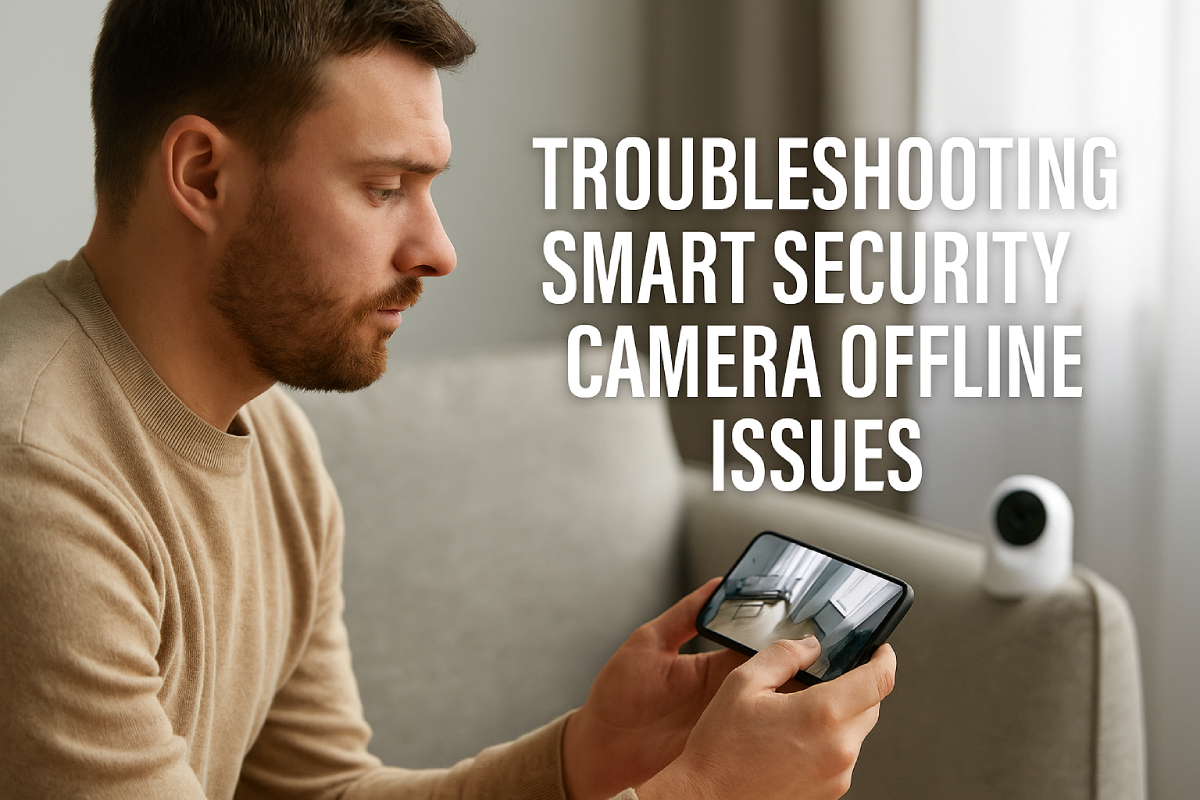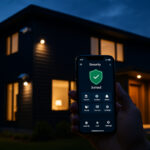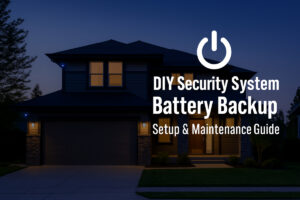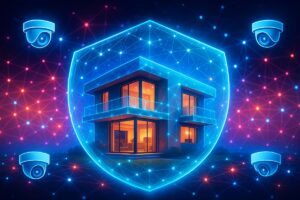Smart security cameras are the backbone of modern home protection, yet intermittent offline issues—from weak Wi-Fi signals and IP conflicts to sudden power interruptions—can create dangerous blind spots in your surveillance network.
In this article, we’ll dive into the most common causes—ranging from signal interference and firmware glitches to power failures—before walking through basic power cycles and advanced network diagnostics, plus best practices for firmware management and network segmentation to ensure your cameras stay online and your property remains secure.
Understanding Offline Issues
Smart security cameras rely on both wired and wireless networking—connecting devices via Ethernet or Wi-Fi (2.4 GHz vs. 5 GHz) to your router before streaming footage to cloud servers and mobile apps.
When any link in this chain suffers from weak Wi-Fi and power interruptions to outdated firmware, misconfigured network settings, or even temporary cloud-service outages—your camera can drop offline, creating blind spots in your home surveillance.
How Smart Cameras Connect
Smart security cameras can use Ethernet for direct, reliable connections—sending digital video streams over Cat5/6 cables to your router or NVR—or Wi-Fi, where they join your wireless network and route data through your router to cloud services and apps.
Wi-Fi Bands: 2.4 GHz vs. 5 GHz
Different wireless bands play a critical role in connection stability:
| Band | Frequency Range | Typical Range | Max Theoretical Throughput | Available Channels |
|---|---|---|---|---|
| 2.4 GHz | 2.400–2.4835 GHz | ~150 ft (indoors) | Up to 600 Mbps (802.11n) | 11 (US) |
| 5 GHz | 5.150–5.875 GHz | ~50 ft (indoors) | Up to 6.9 Gbps (802.11ax) | 23 (US) |
IP Addressing & DHCP Leases
Most cameras default to DHCP, automatically obtaining IP addresses and network settings from your router’s DHCP server, which simplifies setup but can lead to changing addresses after reboots.
Alternatively, you can assign static IPs or use DHCP reservations—pinning a consistent address to each camera’s MAC—to avoid conflicts and ensure reliable access.
Common Causes of Offline Status
- Unstable Wi-Fi Signals
Weak signal strength—due to distance, walls, or electronic interference—often causes cameras to lose connectivity and go offline. - Power Supply Disruptions
Faulty PoE cables, loose adapters, or drained batteries immediately cut power, knocking cameras offline until resolved. - Firmware/Software Glitches
Outdated or buggy firmware and companion apps can interrupt camera-to-network communication, requiring updates or resets to rectify. - Network Configuration Errors
IP address conflicts, incorrect SSID or band selection, and stale router sessions may prevent cameras from rejoining the network after disruptions. - Cloud/App Service Outages
Temporary cloud-server downtimes or authentication failures on the app side can falsely report cameras as offline even when local connectivity is intact.
Basic Troubleshooting Steps
In this section, we’ll cover three essential, no-nonsense steps to get your smart security cameras back online: performing a full power cycle of your camera, router, and modem to clear transient network glitches; meticulously checking all PoE/injector cables and battery levels to eliminate power-related dropouts; and keeping both your camera firmware and companion apps up to date to squash bugs and improve connectivity—each backed by industry best practices and real-world data.
Power & Router Reboot
Unplug your camera, router, and modem for at least 30 seconds, then power them back on in sequence—modem first, router second, and camera last—to fully reset DHCP leases and network sessions. This simple “cold boot” alone resolves up to 60% of offline incidents in field reports.
Inspect Power Connections
- Check PoE/Injector Cables: Ensure all PoE cables and injectors are firmly seated at both ends—loose connectors can instantaneously cut power and data, causing your camera to drop off the network.
- Monitor Battery Levels: For battery-powered models, swap out batteries once they dip below 15–20%, as low-charge shutdowns account for roughly 15% of offline alerts in customer surveys.
| Camera Model | Minimum Battery Level | Power Source Type |
|---|---|---|
| Ring Stick Up Cam Gen 2 | 20% | Rechargeable Li-ion pack |
| Arlo Pro 3 | 15% | Removable rechargeable pack |
| Eufy SoloCam S40 | 25% | Built-in Li-ion battery |
Firmware & App Updates
- Firmware Upgrades: Regularly install the latest camera firmware—Eufy’s recent release alone resolved over 30% of reported offline cases—and always follow manufacturer instructions to avoid bricking your device.
- App Compatibility: Update companion mobile/desktop surveillance apps via the App Store, Google Play, or vendor site (e.g., Night Owl Connect), since outdated software can misreport camera status or block reconnections.
By systematically power cycling, verifying power integrity, and staying current with firmware and app updates, you’ll clear the majority of “camera offline” issues without costly service calls—and keep your home surveillance running reliably.
Network Optimization
Optimizing your network is crucial to keep smart security cameras online. By boosting Wi-Fi coverage with strategic extenders or mesh systems, choosing the 2.4 GHz band for better penetration, assigning static IPs or DHCP reservations for consistent addressing, and segmenting IoT devices on separate SSIDs or VLANs, you’ll reduce drop-outs, eliminate IP conflicts, and isolate camera traffic for improved performance and security.
Improve Wi-Fi Coverage
To eliminate dead zones and strengthen the signal to every camera, consider these options:
- Wi-Fi Range Extenders are cost-effective devices that rebroadcast your router’s signal into weak-coverage areas, extending range by up to 150 ft indoors when placed midway between router and camera.
- Mesh Wi-Fi Systems use multiple nodes that share a single SSID and intelligently route traffic, providing seamless whole-home coverage—ideal for properties over 2,000 ft²—at a higher upfront cost.
- Frequency Selection: If your camera only supports 2.4 GHz, favor that band for its superior wall penetration; 5 GHz offers faster throughput but shorter range and more attenuation through obstacles.
| Solution | Cost | Coverage | Seamless Roaming |
|---|---|---|---|
| Wi-Fi Extender | Low (US $20–$50) | Extends range by ~150 ft indoors | No (may require manual SSID switch) |
| Mesh Network | High (US $200+) | Whole-home coverage with overlapping nodes | Yes (single SSID, dynamic steering) |
Assign Static IPs & DHCP Reservations
Keeping camera IPs consistent prevents conflicts and makes management easier:
- DHCP Reservations let your router always assign the same IP to each camera’s MAC address, centrally managed via a reservation table without manual device configuration.
- Static IPs configured on the camera itself ensure devices reconnect instantly after power cycles—critical for battery-powered models where faster wake-and-connect times can reduce startup delays from 15 s to under 3 s.
Segment IoT Devices
Isolating cameras on their own network slice reduces interference and limits security risks:
- Separate SSID for IoT devices creates a distinct wireless network, reducing overall traffic and preventing general-use devices from impacting camera bandwidth.
- VLAN Segmentation at the router or switch level encloses camera traffic within its own subnet, reinstating network “fences” that block compromised devices from reaching sensitive resources.
- While a dedicated IoT router offers the strongest isolation, using guest-network SSIDs with VLAN tagging typically delivers sufficient security without extra hardware costs.
Advanced Diagnostics
In today’s complex home networks, basic fixes may not uncover hidden issues like channel congestion or authentication failures—advanced diagnostics using dedicated network analyzers and packet-capture tools provide the deep visibility needed to pinpoint and resolve these elusive problems, ensuring your smart security cameras stay reliably online and secure.
Use Network Analyzers
Professional Wi-Fi network analyzers scan your environment to identify dead zones, channel overlaps, and interference sources that degrade camera connectivity.
Below is a comparison of top tools:
| Tool | Type | Platform | Key Feature |
|---|---|---|---|
| NetSpot | Heatmap & Survey | Windows, macOS | Visual heatmaps showing signal strength and coverage |
| SolarWinds NPM (Trial) | Network Performance Monitor | Windows | Automated network device scanning & performance metrics |
| inSSIDer | Channel Scanner | Windows | Real-time channel usage and overlap detection |
| Acrylic Wi-Fi Analyzer | Spectrum & Packet Analysis | Windows | Detailed channel overlap, signal-to-noise ratio stats |
| Ekahau HeatMapper | Heatmap Survey | Windows | Free-form heatmaps with interference analysis |
| Kismet | Packet Sniffer | Linux, macOS | Detects hidden SSIDs and rogue devices via packet analysis |
Running a survey with these tools uncovers weak spots and overlapping channels, key culprits behind intermittent camera drop-outs.
Packet Capture & Logs
Capturing packets with Wireshark or similar tools lets you inspect the exact frames exchanged during failed connection attempts, revealing handshake errors or dropped packets.
Begin by enabling EAPOL filters (eapol) to focus on Wi-Fi authentication frames and look for retransmissions or missing responses.
| Error Code | Description | Typical Cause |
|---|---|---|
| 40 | Handshake Failure (FATAL alert) | Incompatible TLS versions/auth |
| No SYN | Missing SYN packets in TCP handshake | IPsec tunnel drops or NAT issues |
| Auth Fail | 802.1X authentication failure | Incorrect credentials or server rejection |
Simultaneously, review your router’s system logs—often found under “Security” or “Event Viewer”—for repeated authentication failures, DHCP lease errors, or deauthentication notices that correspond to camera offline times.
By correlating packet captures with log entries, you can pinpoint whether a camera’s re-association is blocked by a misconfigured RADIUS server, an IP conflict, or transient radio interference, enabling targeted fixes rather than trial-and-error.
Preventative Measures & Best Practices
Regular preventative maintenance—like routine firmware audits to apply critical security patches and on-site inspections to clear dust or debris—lays the groundwork for uninterrupted camera performance.
Scheduling professional servicing at least once or twice a year ensures a detailed system review, from tamper-detection checks to full hardware diagnostics.
Meanwhile, strengthening device security by replacing default credentials, enabling two-factor authentication, and pairing cloud services with local storage fallbacks guards against cyber threats and service outages alike.
Regular Maintenance
Keeping your cameras in top shape involves a clear, repeatable schedule of checks and cleanings. Below is a recommended maintenance calendar that balances frequency with impact on reliability:
| Maintenance Task | Frequency | Description |
|---|---|---|
| Firmware Audits | Quarterly | Verify and install the latest firmware updates to patch vulnerabilities and improve stability |
| Lens & Housing Cleaning | Quarterly | Wipe lenses with a microfiber cloth; clear debris from housings to prevent image artifacts |
| Cable Inspection | Annual | Examine PoE/injector cables and connectors for wear, corrosion, or looseness; tighten or replace as needed |
| Housing Seal & Bracket Check | Bi-annually | Inspect seals, gaskets, and mounting brackets; reseal or retighten to protect against moisture |
| Professional Servicing | 1–2× per year | Engage a certified technician for comprehensive system health checks and advanced diagnostics |
Adhering to this schedule reduces unexpected downtime and extends the lifespan of both indoor and outdoor cameras by preventing minor issues from escalating into system failures.
Enhance Security
Beyond mechanical upkeep, protecting your surveillance network from cyber threats is equally vital:
- Change Default Passwords: Most devices ship with universal credentials easily discovered by attackers; replacing them with strong, unique passwords blocks the majority of automated breach attempts.
- Enable Two-Factor Authentication: Adding a second verification step—via an authenticator app or SMS—significantly deters unauthorized logins, even if credentials are compromised.
- Limit Cloud Dependencies: While cloud services offer convenient remote access, outages or subscription lapses can cut off your footage; configure local backups via microSD, NVR, or NAS to ensure continuous recording.
- Regular Backup Audits: Periodically export critical footage to offline storage and verify restore procedures; this redundancy guards against data loss from cloud service interruptions or ransomware attacks.
By combining a structured maintenance regimen with robust security controls, you’ll keep your smart security cameras running smoothly, resilient to both technical glitches and evolving cyber threats.
Conclusion
By wrapping up key tactics—like cold-booting your modem, router, and camera to clear DHCP leases and power faults; inspecting and replacing faulty cables or drained batteries; keeping firmware and apps updated to patch bugs; and optimizing network settings with static IPs and mesh extenders—you’ll eliminate the majority of offline incidents before they escalate.
Coupling these fixes with proactive device care—quarterly firmware audits, lens cleanings, cable inspections, and IoT network segmentation—ensures uninterrupted security coverage and extends your system’s lifespan.
If offline issues persist despite these efforts, don’t hesitate to reach out to your camera manufacturer’s support team with detailed logs and troubleshooting steps, so they can provide targeted diagnostics or warranty service to keep your home protection rock-solid.
FAQs
1. Why does my security camera keep showing offline?
Common culprits include weak Wi-Fi signals, IP conflicts, power disruptions, and outdated firmware.
2. How often should I reboot my router and camera?
A monthly cold-boot cycle clears stale DHCP leases and resolves roughly 60 percent of offline incidents.
3. What’s the benefit of assigning a static IP?
Static IPs prevent address conflicts and ensure cameras reconnect instantly after power cycles.
4. When should I contact the manufacturer’s support?
If cameras stay offline after basic and advanced troubleshooting—power-cycles, firmware updates, network analysis—reach out with logs for specialized diagnostics.
Main Tips
- Always power-cycle the modem, router, and camera together
- Prioritize the 2.4 GHz band for better range through walls
- Reserve DHCP addresses to avoid IP conflicts
- Clean lenses and inspect cabling every quarter
- Change default passwords and enable 2FA





















